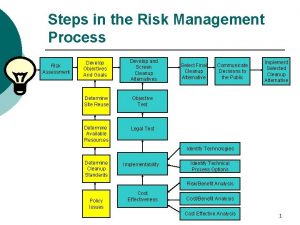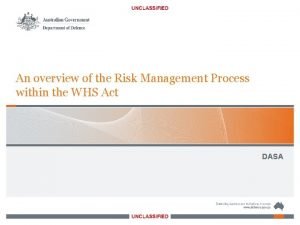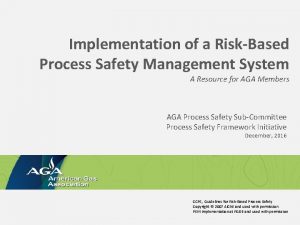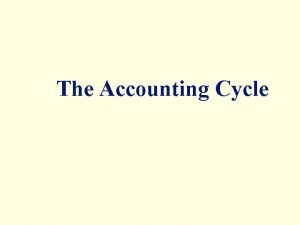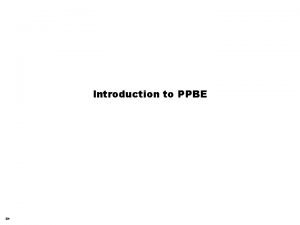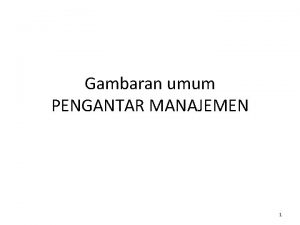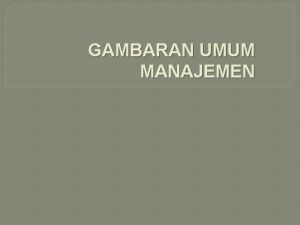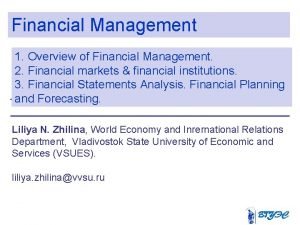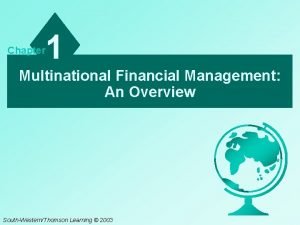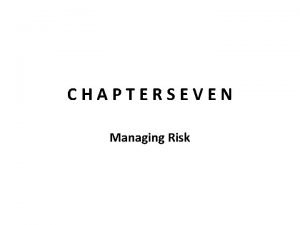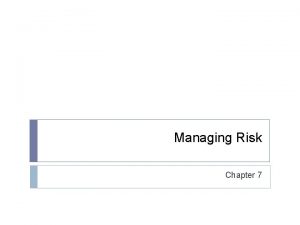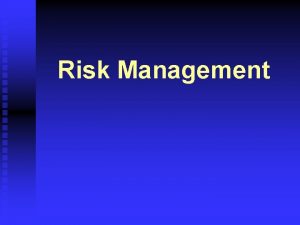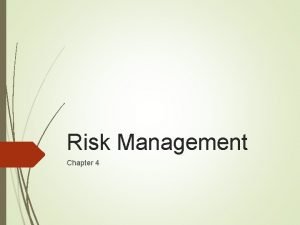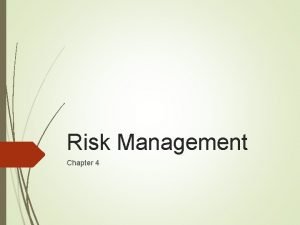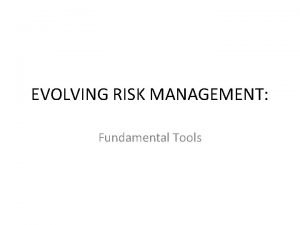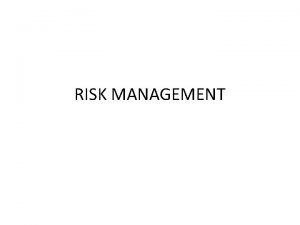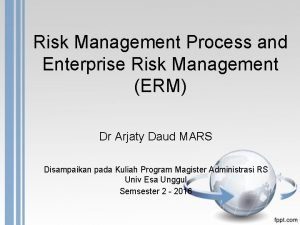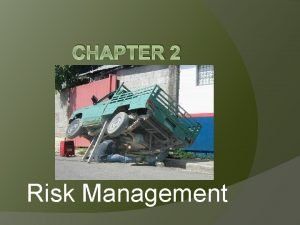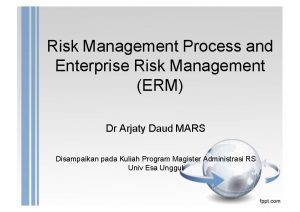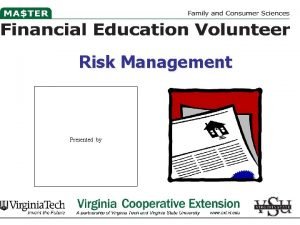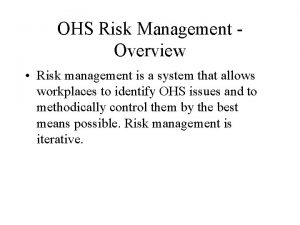An overview of the Risk Management Process within

























- Slides: 25

An overview of the Risk Management Process within the WHS Act DASA

Scope • Hazard / Risk • Why do we assess risk • How have we injured our people & Why • Your WHS Duties, Role & Responsibilities • Overview 7 Step Risk Management process

Why do we manage hazards/risks? • • • Prevent injury Prevent loss or damage to capability Achieve capability outcomes and objectives Maintain the good reputation of the ADF Comply with WHS legislation Protecting our people and capability is the right thing to do


Why are we injuring our people and exposing them to unnecessary risk? • Poor application of Risk Management • Proactive • Hazard identification & reporting • Deliberate RM • Controls implemented and/or OIP updated • Associated training and safety communications • Immediate RM • Tools EG. PEAR & Ro. T • Implementing and/or complying with controls (OIP) • Maintaining risk awareness • Reactive/ Responsive • Safety event investigation & reporting • Predictive • Data trend analysis • Performance monitoring, measurement, analysis, reporting & review Common theme is poor application of Risk Management

How do we need to manage workplace hazards/risks? • You can apply the 7 Step Risk Management process to every task/activity • Deliberate RM well before the task/activity • Eliminate hazards/risks SFARP • Minimise hazards/risks SFARP • Immediate RM immediately before and during the task/activity • Eliminate hazards/risks SFARP • Minimise hazards/risks SFARP • Compliant but flexible/adaptive culture Protecting our people and capability is the right thing to do

Your WHS Duties DUTIES OF WORKERS • WHS Act s. 28 While at work a worker must: • Take reasonable care for his or her own health and safety • Take reasonable care that his or her acts or omissions do not adversely affect the health and safety of other persons • Comply, so far as the worker is reasonably able, with any reasonable instruction that is given by [Defence] to allow the person to comply with this act; and • Co-operate with any reasonable policy or procedure of [Defence] relating to health and safety at the workplace that has been notified to the worker All AF personnel are considered to be ‘Workers’ under the WHS Act

Your Role and Responsibilities The worker’s duty to take ‘reasonable care’ is proportionate to the control that worker is able to exercise over his or her work activities and work environment While all members are workers, your individual role and responsibilities within Air Force are relevant to s. 28 of the Act May have multiple roles and responsibilities as a commander, manager and supervisor Know, Understand, Resource, Monitor, Comply, Verify

Commanders Role & Responsibilities • In the context of Risk Management, Commanders are responsible for: • Understanding their Unit operations and the associated risks to the health & safety of their Workers. • Ensuring all reasonably practicable steps have been taken to eliminate risk • Ensuring all reasonably practicable steps have been taken to minimise risk where it is not reasonably practicable to eliminate • Ensure Deliberate RM is documented – including why risk cannot be eliminated • Providing sufficient resources to effectively manage risk • Remaining vigilant for new risks and inadequate controls in the workplace • Providing sufficient induction programs to new Workers and Visitors • Applying the WHS Due Diligence requirements Know, Understand, Resource, Monitor, Comply, Verify

Managers Role & Responsibilities • In the context of Risk Management, Managers are responsible for: • Ensuring the 7 -Step RM Process is used to assess hazards and risks in the workplace • Proactively identifying situations where RM controls may be inadequate • Taking all reasonable steps to address hazards and risks raised by Workers • Allocating sufficient resources for risk assessment, management, review and maintenance of controls • Reporting deficiencies and/or providing feedback up the chainof-command where appropriate Know, Understand, Resource, Monitor, Comply, Verify

Supervisors Role & Responsibilities • In the context of Risk Management, Supervisors are responsible for: • Ensuring their subordinates are aware of their duties, workplace hazards and risk controls • Incorporating risk monitoring and review processes into all tasks/activities • applying PEAR and Ro. T, or other tools • Enforcing risk controls • Compliance with OIP • Implementation of controls (eg, PPE) Know, Understand, Resource, Monitor, Comply, Verify

Safety Specialists Role & Responsibilities • In the context of Risk Management, Safety Specialists are responsible for: • Providing specialist RM advice to commanders, managers and supervisors to support them in discharging their responsibilities • Providing SME support to proactive and predictive RM • Conducting effective reactive RM (safety investigation) Know, Understand, Resource, Monitor, Comply, Verify

7 Step Risk Management Process

Elimination Control Assessment • Assess each elimination control to determine: – Its availability – Its suitability – Its cost of implementation – Whether the cost of implementation is grossly disproportionate to the benefit gained – Whether it is reasonably practicable – Whether it is immediately implementable

Reasonably Practicable & Immediately Implementable • An elimination or minimisation control is Reasonably Practicable if it is: • Available • Suitable • Not grossly disproportionate • If Reasonably Practicable, obligated to implement • An elimination or minimisation control is immediately implementable if: • resources • support measures • monitoring mechanisms physically exist, are readily available or already established

7 Step Risk Management Process

Diminishing Benefit to Risk Minimisation

Minimisation Control Assessment • Assess each minimisation control to determine: – Its availability – Its suitability – Its cost of implementation – Whether the cost of implementation is grossly disproportionate to the benefit gained – Whether it is reasonably practicable – Whether it is immediately implementable

7 Step Risk Management Process

Defence Harmonised Risk Matrix

7 Step Risk Management Process

Risk Decision & Escalation Framework

7 Step Risk Management Process

7 Step RM Process – Key Points • • • Not a significant divergence from current RM approach RM must be applied to all tasks/activities All 7 Steps apply to Deliberate RM Intent of Immediate RM is not to redo Deliberate RM The requirement to consider elimination of hazards/risks does not necessarily mean ceasing a task/activity • Only need to document Deliberate RM decisions Don’t let mission focus defeat sensible risk controls

Key Messages • Commanders, managers and supervisors must set the safety tone in their workplaces by: • understanding hazards, risks and controls • recognising their due diligence obligations • encouraging reporting of hazards and safety events • escalating support issues to upstream agencies • providing reputable information to Chief of Air Force • recognising positive behavior • ensuring incidents are investigated properly • All workers are responsible for supporting the above
 Credit risk market risk operational risk
Credit risk market risk operational risk Key risk indicators template
Key risk indicators template Risk map
Risk map Risk management phases
Risk management phases Contract risk management process
Contract risk management process Dlc117: the risk management (rm) process
Dlc117: the risk management (rm) process Ccps psm elements
Ccps psm elements Trial balance junior cert
Trial balance junior cert Ppbe process overview
Ppbe process overview Process indicators enable a software project manager to
Process indicators enable a software project manager to Web content management tools capabilities
Web content management tools capabilities Nature of hrm
Nature of hrm Project management overview
Project management overview Gym management system website
Gym management system website The forrester wave real time interaction management q2 2017
The forrester wave real time interaction management q2 2017 Management overview
Management overview 4 prinsip taylor dalam tahapan
4 prinsip taylor dalam tahapan Overview of financial management
Overview of financial management What is multinational financial management
What is multinational financial management Chapter 1 an overview of financial management
Chapter 1 an overview of financial management An overview of financial management
An overview of financial management Risk projection attempts to rate each risk in two ways
Risk projection attempts to rate each risk in two ways Risk management avoidance
Risk management avoidance Relative risk calculation
Relative risk calculation Residual risk and secondary risk pmp
Residual risk and secondary risk pmp Ar = ir x cr x dr
Ar = ir x cr x dr



